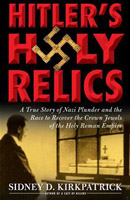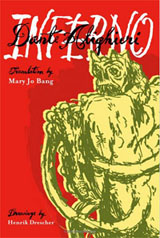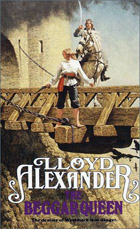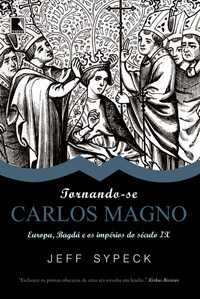 For five years, this blog has documented medievalism from Louisiana to Serbia to Ossetia to the banks of the Potomac and the putting greens of Ocean City, but there’s one manifestation I’ve dreaded: Nazism. I don’t hesitate to point out dreary forms of medievalism, but I figured the Third Reich’s version of it would be especially awful. It is—so I’m grateful to Sidney D. Kirkpatrick for summarizing it in what’s probably the only book to feature both Nazis and art historians that can properly be called a great “beach read.”
For five years, this blog has documented medievalism from Louisiana to Serbia to Ossetia to the banks of the Potomac and the putting greens of Ocean City, but there’s one manifestation I’ve dreaded: Nazism. I don’t hesitate to point out dreary forms of medievalism, but I figured the Third Reich’s version of it would be especially awful. It is—so I’m grateful to Sidney D. Kirkpatrick for summarizing it in what’s probably the only book to feature both Nazis and art historians that can properly be called a great “beach read.”
Published in 2010, Hitler’s Holy Relics tells the story of the late Walter Horn, known to medievalists as co-founder of the art history department at UC-Berkeley and co-author of The Plan of St. Gall. As World War II wound down in Europe, Horn was a 36-year-old lieutenant for the U.S. Army; he was born and educated in Germany and had fled as recently as 1938, which made him useful as an interrogator. In February 1945, after a desperate prisoner squealed about a secret bunker under Nuremberg Castle, Lieutenant Horn investigated an incredible stash of artwork and relics, including the reputed Holy Lance and the coronation garments of the Holy Roman Emperor.
There was one problem: the Crown Jewels of the Holy Roman Empire—the crown, globe, scepter, and two swords—were missing, and the Allies feared the objects might be used to rally neo-Nazis as the Nuremberg trials began.
Horn was uniquely qualified to search for them. He had studied under magisterial art historian Erwin Panofsky at Hamburg and personally knew many of Germany’s top curators, art historians, and dealers. Plus, unlike many members of the Army’s commission on monuments and antiquities, he wasn’t a curator looking to enhance a museum collection back in the States. (A true academic, Horn carried a draft of his scholarly article about a Florentine basilica across seven countries. He fearlessly interrogated Nazis but was reluctant to submit his work for peer review.) In late July 1945, Horn was given just three weeks to find the lost Crown Jewels before a repatriation conference in Munich would render his mission moot—and the faster he could get it done, the more time he’d have to search the Soviet Zone for the family he left behind.
Kirkpatrick tells this story well, painting a dense, believable picture of postwar chaos. As the occupying army compromises with conquered locals, Walter Horn sees his birth nation in ruins, wonders about the fate of his family and friends, and hunts for treasure even when questions of cultural patrimony pale against the enormity of the entire war. Despite its lurid cover, Hitler’s Holy Relics is sensitive to the stories of individuals, not armies, from a Nazi museum curator who survives by hiding his homosexuality to the personal interest Patton himself takes in the Crown Jewels.
It’s also sensitive to the allure of medievalism, as Kirkpatrick sketches out the creepy ways in which high-ranking Nazis mixed medieval myth with occultism in an effort to raise up a truly freakish world. Kirkpatrick summarizes the legends surrounding the Holy Lance, which beguiled a young Hitler when he saw it in an Austrian museum. He also describes the work of the Ahnenerbe, the SS “think tank” dedicated to such projects as locating the Holy Grail and forcing Finnish psychics to contact Nordic spirits. Kirkpatrick details Hitler’s plans to turn Nuremberg, home of the Crown Jewels, into a bizarre neo-medieval theme park, and he takes us, via Walter Horn, to Heinrich Himmler’s insane castle, which was renovated by enslaved Jehovah’s Witnesses, furnished with an Arthurian Round Table and rune-inscribed teacups, and designed to resemble, from the air, the tip of the Holy Lance.
Notably free of the usual Discovery Channel baloney—there’s only one dubious case of wild speculation, and it comes from Walter Horn himself—Hitler’s Holy Relics is a terrific read. Kirkpatrick corrects errors in earlier, more lurid accounts of Horn’s adventures and makes clear to a non-scholarly audience why art and architecture aren’t mere ornamentation, but powerful political tools. In doing so, he confirms a chilling observation by scholar Tom Shippey that’s worth keeping in mind as you suit up for the Ren Fest this fall: “There are…many medievalisms in the word, and some of them are as safe as William Morris wallpaper: but not all of them.”


 “Imagine a contemporary translation of Dante that includes references to Pink Floyd, South Park, Donald Rumsfeld, and Star Trek,”
“Imagine a contemporary translation of Dante that includes references to Pink Floyd, South Park, Donald Rumsfeld, and Star Trek,”  In May 2008, one year after the death of Lloyd Alexander, I read his autobiographical novel
In May 2008, one year after the death of Lloyd Alexander, I read his autobiographical novel  [Here’s the final post in a series of reviews of all of Lloyd Alexander’s non-Prydain books. To see all posts in this series, click on the
[Here’s the final post in a series of reviews of all of Lloyd Alexander’s non-Prydain books. To see all posts in this series, click on the  [Here’s the latest in an ongoing series of reviews of all of Lloyd Alexander’s non-Prydain books. To see all posts in this series, click on the
[Here’s the latest in an ongoing series of reviews of all of Lloyd Alexander’s non-Prydain books. To see all posts in this series, click on the  There’s nothing quite as weird as sitting at home, sweating off a muggy August noon like a forsaken tumbler of iced
There’s nothing quite as weird as sitting at home, sweating off a muggy August noon like a forsaken tumbler of iced  [Here’s the latest in an ongoing series of reviews of all of Lloyd Alexander’s non-Prydain books. To see all posts in this series, click on the
[Here’s the latest in an ongoing series of reviews of all of Lloyd Alexander’s non-Prydain books. To see all posts in this series, click on the  [Here’s the latest in an ongoing series of reviews of all of Lloyd Alexander’s non-Prydain books. The second and third Westmark novels will be covered in subsequent posts. To see all posts in this series, click on the
[Here’s the latest in an ongoing series of reviews of all of Lloyd Alexander’s non-Prydain books. The second and third Westmark novels will be covered in subsequent posts. To see all posts in this series, click on the  [Here’s the latest in an ongoing series of reviews of all of Lloyd Alexander’s non-Prydain books. To see all posts in this series, click on the
[Here’s the latest in an ongoing series of reviews of all of Lloyd Alexander’s non-Prydain books. To see all posts in this series, click on the